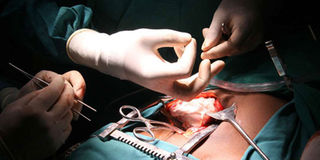Happening Now: Gachagua in court for hearing of impeachment case
Openness can promote patient safety

Kenyatta National Hospital doctors conduct a kidney transplant on August 27, 2013. PHOTO | NATION MEDIA GROUP
What you need to know:
We need to create an environment in which health workers feel that they can share information about medical errors without being unjustly victimised.
In most cases around the world, state medical boards are charged with punishing medical malpractice with some incidents escalated to law courts.
Most Kenyans believe that patient safety standards in our country are a drastic far cry from global benchmarks, citing a recent case at Kenyatta National Hospital as well as others in various public and private hospitals.
But while it is tempting to believe this, the reality is that medical error is a global problem. In a recent study, John Hopkins patient safety experts estimated that medical error was the third-highest cause of death in the United States. In findings published in the British Medical Journal in May 2016, medical errors accounted for 10 per cent of all US deaths.
Medical error is not unique to Kenya. It occurs elsewhere, sometimes with greater prevalence and direr consequences on human life. The difference is how cases are handled and whether a culture of sharing information and addressing core issues is promoted.
We need to create an environment in which health workers feel that they can share information about medical errors without being unjustly victimised. Accurate and timely information empowers decision makers in the healthcare system to identify and address the root causes of preventable errors.
HUMAN ERROR
In most cases, the root issue is human error. At KNH, measures taken to address human error include tightening enforcement of standard operating procedures and improving patient-provider communications and patient tagging.
In some cases, the challenge is a broader health systems issue — such as shortage of health workers. The shortage of nurses in Kenya, is particularly worrying, and has a material effect on patient safety standards. The Kenya Healthcare Workforce Report shows the ratio of practising nurses to the population as 8.3 per 10,000 against the World Health Organisation (WHO) recommended limit of 25:10,000.
The dire shortage against huge demand contributes to fatigue and increases chances of human error. This points to the need to increase training of nurses and review recruitment. We also need to treat individual cases as a window into our health system. For instance, why are our referral hospitals perpetually overcrowded, with bed occupancy at KNH sometimes hitting 120 per cent?
RECKLESS BEHAVIOUR
Primary healthcare has, historically, been given limited attention in Kenya. A patient who could have received basic treatment at a local clinic ends up at KNH, leading to overcrowding and compromising patient safety standards. These issues need to be addressed.
However, a few cases of medical error are caused by reckless behaviour among health practitioners who violate patient safety rules. If this is suspected, disciplinary action should be taken, subject to proper investigations. In most cases around the world, state medical boards are charged with punishing medical malpractice with some incidents escalated to law courts.
A case in point is the highly publicised case involving Dr. Conrad Murray, who was Michael Jackson’s personal physician. In 2012, the American doctor was convicted of involuntary manslaughter in the death of the pop star and received a four-year jail sentence.
CONTINOUS MONITORING
He routinely administered Propofol as a sleeping remedy to Jackson at the comfort of the late musician’s home, despite the fact that any patient who receives the surgical anaesthetic requires continuous monitoring of heart rate and breathing in an equipped medical facility.
But health practitioners also need to be reminded of their commitment to not only deliver clinical excellence, but also treat patients with respect and empathy. This promotes a good patient-provider relationship, making it easier for the former to share information that would lead to better treatment and higher safety standards.
Dr Okutoyi is the head of department, Quality Healthcare, at KNH. [email protected]




